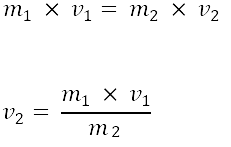
Momentum, Isaac Newton and Cannons
This page extends the examples given in the momentum calculator page and shows how to calculate recoil from a
cannon. A calculator is included as well as an example to try involving an astronaut floating in space.

Advertisement
Calculate the velocity of v
2

Let’s say we have a cannon that has a mass of 600 kg, and it fires a cannonball
with a mass of 1.5 kg at a velocity of 250 ms
-1
.
According to Newton’s Third Law of Motion for every action there is an opposite
and equal reaction. Therefore, as the cannonball is fired the cannon itself must
move in the opposite direction.
Intuition will tell that the cannon, being heavier than the cannonball, won’t move
very far or very fast, but just how fast will it move?
This is where an understanding of momentum comes to the rescue!

The rearranged equation is:



Momentum, Newton and Cannons

The equation for momentum is p = m x v , and if we have a balancing of
momentum we can say that m x v = m x v. That is, the momentum of one
side must be equal to the momentum on the other side.
We said that the cannon has a mass of 600 kg so we will call that m
2
. It
fires a cannonball with a mass of 1.5 kg (m
1
) at a velocity of 250 ms
-1
(v
1
), so we have all the data required and we simply need to rearrange
the equation, put the numbers into it and do the calculation to find v
2
, i.e.
the velocity of the cannon.
The rearranged equation is shown on the right and here is a calculator
(enter all figures without commas. For example, enter 2,400 as 2400):

Where:
m
1
= mass of the first object (kg)
v
1
= velocity of the first object (ms
-1
)
m
2
= mass of the second object (kg)
v
2
= velocity of the second object (ms
-1
)
So:
So the cannon recoils with a velocity of 0.625 ms
-1
. Note that these are initial velocities. The cannon will soon slow to a
stop because of the friction of its wheels on the ground. The cannonball, on the other hand, is moving through the air
and so will take much longer before it slows to a stop.
An astronaut in space example
A stationary astronaut with a mass of 120 kg throws a hammer with a mass of 2 kg at a velocity of 12 ms
-1
. What will
the astronaut’s velocity be afterwards?
Note: This could seem like a trick question. After all, the astronaut and the hammer will both be weightless. However,
weight is a function of the pull of gravity, but the mass remains the mass and is the same whether on the Earth, the
Moon or in free space. Hammers still work in space because they still have mass.
One other point to note is that unlike the cannon and cannonball, the astronaut is subject to only a very tiny amount
of friction, at the most. This could result in an unstoppable drift into space at a constant velocity, which could of
course be countered by throwing something of the right mass and at the right speed in the opposite direction.



Advertisement

Momentum, Issac Newton and
Cannons



Momentum, Isaac Newton and Cannons
This page extends the examples given in the momentum
calculator page and shows how to calculate recoil from a cannon.
A calculator is included as well as an example to try involving an
astronaut floating in space.

Let’s say we have a cannon that has a mass of 600 kg, and it
fires a cannonball with a mass of 1.5 kg at a velocity of 250 ms
-1
.
According to Newton’s Third Law of Motion for every action there
is an opposite and equal reaction. Therefore, as the cannonball is
fired the cannon itself must move in the opposite direction.
Intuition will tell that the cannon, being heavier than the
cannonball, won’t move very far or very fast, but just how fast will
it move?
This is a question of momentum!
The rearranged equation is:

Where:
m
1
= mass of the first object (kg)
v
1
= velocity of the first object (ms
-1
)
m
2
= mass of the second object (kg)
v
2
= velocity of the second object (ms
-1
)
So:
Enter all figures without commas. For example, enter 2,400 as
2400):
Calculate the velocity of v
2
So the cannon recoils with a velocity of 0.625 ms
-1
. Note that
these are initial velocities. The cannon will soon slow to a stop
because of the friction of its wheels on the ground. The
cannonball, on the other hand, is moving through the air and
so will take much longer before it slows to a stop.
An astronaut in space example
A stationary astronaut with a mass of 120 kg throws a hammer
with a mass of 2 kg at a velocity of 12 ms
-1
. What will the
astronaut’s velocity be afterwards?
Note: This could seem like a trick question. After all, the
astronaut and the hammer will both be weightless. However,
weight is a function of the pull of gravity, but the mass remains
the mass and is the same whether on the Earth, the Moon or in
free space. Hammers still work in space because they still have
mass.
One other point to note is that unlike the cannon and cannonball,
the astronaut is subject to only a very tiny amount of friction, at
the most. This could result in an unstoppable drift into space at a
constant velocity, which could of course be countered by
throwing something of the right mass and at the right speed in
the opposite direction.
The equation for momentum is p = m x v , and if we have a
balancing of momentum we can say that m x v = m x v. That is,
the momentum of one side must be equal to the momentum on
the other side.
We said that the cannon has a mass of 600 kg so we will call that
m
2
. It fires a cannonball with a mass of 1.5 kg (m
1
) at a velocity of
250 ms
-1
(v
1
), so we have all the data required and we simply
need to rearrange the equation, put the numbers into it and do
the calculation to find v
2
, i.e. the velocity of the cannon.
The rearranged equation is shown on the below followed by a
calculator:
